Cabinets & Desks
A GEORGE III MARQUETRY COMMODE ATTRIBUTED TO PIERRE LANGLOIS
W: 157cm / 62"
D: 63cm / 24”
Further images
-
(View a larger image of thumbnail 1
)
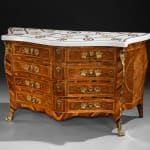
-
(View a larger image of thumbnail 2
)
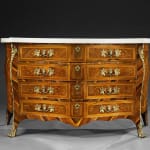
-
(View a larger image of thumbnail 3
)
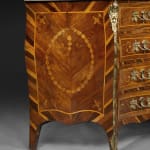
-
(View a larger image of thumbnail 4
)
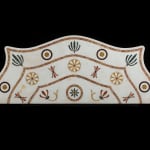
-
(View a larger image of thumbnail 5
)
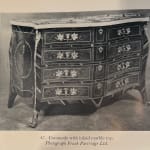
-
(View a larger image of thumbnail 6
)
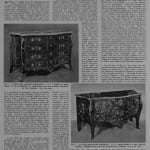
-
(View a larger image of thumbnail 7
)
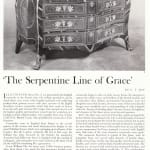
-
(View a larger image of thumbnail 8
)
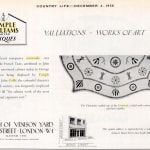
-
(View a larger image of thumbnail 9
)
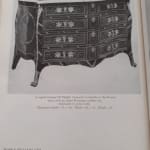
Provenance
Temple Williams Ltd., 1958
Frank Partridge Ltd., before 1968
The Collection of Lord & Lady Weinstock
Exhibitions
Temple Williams, The Grosvenor House Art & Antiques Fair, London, 1959Literature
Rieder, W., ‘More on Pierre Langlois’, The Connoisseur, September 1974, pp. 11-13
Thornton, P. & Rieder, W., ‘Pierre Langlois, Ébéniste. Parts 1-5’, The Connoisseur, December 1971, pp. 283-288; February 1972, pp. 105-112; March 1972, pp. 176-187; April 1972, pp. 260-262, fig. 15; and May 1972, pp. 30-35
Wood, L., ‘New Light on Pierre Langlois (1718-67)’, The Furniture History Soc. Newsletter, No. 196, Nov. 2014
Publications
Coleridge, A., Chippendale Furniture (London: 1968), p. 35, pl. 47
Davis, F., ‘A Page for Collectors: A Forgotten English Cabinet-Maker’, Illustrated London News, 3rd Jan. 1959
Joy, E. T., ‘The Serpentine Line of Grace’, The Connoisseur, Antique Dealers Fair Souvenir Ed., 1959, pp. 72-74
Temple Williams Limited Antiques, Advertisement, Country Life, 4th Dec. 1958
Temple Williams LTD, The Grosvenor House Handbook (London, 1959), p. 96
A Commode Attributed to Pierre Langlois
London, circa 1765–70
Attribution and Background
This commode, with its refined naturalistic floral marquetry, is attributed to Pierre Langlois, one of the most distinctive and accomplished cabinetmakers working in mid-18th century London. Born in England to Huguenot parents, Langlois trained in Paris—most likely in the workshop of the celebrated ébéniste Jean-François Oeben during the 1740s—before establishing his practice in London around 1759. He quickly became one of the few craftsmen capable of importing the sophisticated vocabulary of Parisian rococo cabinet-making into English interiors at a time when the Seven Years’ War (1756–63) had severely disrupted the importation of foreign luxury goods.
Marquetry and Decorative Style
The present commode exemplifies Langlois’ signature style, with its striking marquetry of fustic, amaranth, and other coloured woods set against a dark rosewood ground to produce strong tonal contrasts. This technique—panels of light woods on rich mahogany or rosewood veneers—is a hallmark of Langlois’ mature work. So too is the use of sharply defined diagonal striping across the front, sides, and top (when in wood) to form geometric frameworks for marquetry panels, a feature clearly evident in this piece.
The marquetry decoration itself reinforces the attribution. Langlois had a notable fondness for inserting fleur-de-lys into his designs—a French royal motif unlikely to have appealed to English-trained cabinetmakers of the period. On the present commode, the fleurs-de-lys appear at each corner of the side panels and beneath the escutcheons on the drawer fronts, a recurring detail found across nearly all of his decorated pieces, except those of a more sober character.
Ormolu Mounts and Patronage
Equally characteristic are the finely cast ormolu mounts, in particular the scroll toe mounts, which closely resemble those on Langlois’ documented commissions for some of the most important British patrons of the day. These include a suite of commodes supplied to the Duke of Bedford for Woburn Abbey in 1760, the Earl of Coventry at Croome Court in 1764, and others attributed to Langlois for Sir Lawrence Dundas and John Chute, as well as pieces now in the Royal Collection.
Form and Stylistic Significance
The curvilinear form of the commode is another French import Langlois helped popularise in England. Its softly bowed façade and gently curved back edge recall continental models and diverge markedly from the rectilinear outlines typical of English cabinet-making in the 1760s. The overall silhouette suggests Langlois’ role in advancing the Rococo aesthetic in Britain, especially in the period of transition toward Neoclassicism.
Dating from circa 1765–70, this commode was produced at a moment of stylistic evolution, as elements of Rococo exuberance began to give way to the cleaner lines and symmetry of Neoclassicism. The design remains firmly rooted in the Rococo tradition but anticipates the restrained classical taste later embraced by Langlois’ son, Daniel Langlois, whose signed piece in the Fitzwilliam Museum, along with a related pair at Woburn Abbey, are more advanced in Neoclassical expression and are dated no earlier than 1770.
Construction and Materials
Constructional details further support the attribution. The commode’s black-washed, double-panelled back and finely executed interior are both consistent with Langlois’ known workshop practice. Moreover, the use of a marble top—here a particularly lavish white serpentine slab inlaid with Spanish brocatelle borders, anthemion motifs, and floral roundels in giallo, rouge griotte, and vert de mer—reflects the French tradition Langlois imported. In contrast to English preferences for veneered wooden tops, such elaborate stonework was almost exclusively a Parisian convention at the time.
Conclusion
The present commode, richly executed and stylistically sophisticated, stands as an important example of Langlois’ work and the broader French influence on English furniture-making in the second half of the 18th century. It has been widely illustrated and admired for its exceptional craftsmanship and historical significance.








